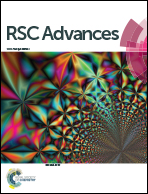Synthesis and characterization of biobased polyurethane/SiO2 nanocomposites from natural Sapium sebiferum oil
Abstract
Novel Sapium sebiferum oil-based polyurethane (PU) nanocomposites with different contents of nano-SiO2 were successfully synthesized via an in situ polymerization method. Firstly, Sapium sebiferum polyol (SSP) was prepared in a continuous two-step process of epoxidation and hydroxylation, and nano-SiO2 particles were modified with 3-aminopropyltriethoxysilane (AMEO). Furthermore, SSP and isophorone diisocyanate (IPDI) reacted with a certain amount of the modified nano-SiO2 to enhance the physical properties of PU nanocomposites. The characterization of the structure and the properties of the surface modified nano-SiO2 and the PU/SiO2 nanocomposites were analyzed by Fourier transform infrared (FTIR), thermogravimetric analysis (TGA), solid-state 29Si nuclear magnetic resonance (NMR), scanning electron microscopy (SEM) and differential scanning calorimetry (DSC). The results demonstrate that nano-SiO2 particles can be homogeneously dispersed in the PU matrix with a loading amount less than 5 wt%. Compared with the pure PU, the glass transition temperatures and initial decomposition temperatures of the PU/SiO2 nanocomposites were respectively enhanced by 20.5 °C and 43.5 °C with 3 wt% nano-SiO2 content. Moreover, the tensile strength of the PU/SiO2 nanocomposites was improved at 170%, and the water and toluene resistance properties of PU/SiO2 were also significantly enhanced.


 Please wait while we load your content...
Please wait while we load your content...